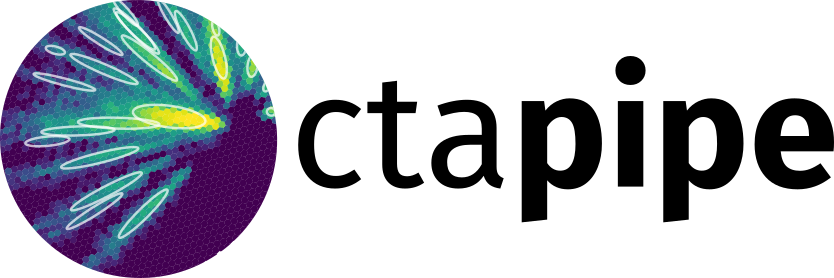How to use the cut optimization and the irf tool to create an IRF using ctapipe#
This guide explains how to create an IRF using two ctapipe tools from DL2 files.
The first step is the optimization of gamma/hadron cuts and cuts on the origin direction
using ctapipe-optimize-event-selection.
The second step is the calculation of the IRF itself using ctapipe-compute-irf,
which also applies the previously optimized g/h cuts and optionally the cuts on the origin direction.
Note
This guide assumes you have a directory containing gamma, proton, and electron files already containing reconstructed energy, particle type, and direction (DL2).
The provided commands also assume you are trying to process files in a
bashshell environment.
Setup#
First define the following environment variables. It is recommended to use different files for the cut optimization and the calculation of the IRF to avoid overestimating the performance due to the cuts being over-adjusted for the individual files.
OUTPUT_DIR, the directory in which to save all the output filesOPT_CONFIG_FILE, a configuration file for the optimization step, e.g.optimize_cuts.yamlIRF_CONFIG_FILE, a configuration file for making irfs without a cut on the origin direction, e.g.compute_irf.yamlGAMMA_OPT_FILE, the gamma file used to optimize selection cutsPROTON_OPT_FILE, the proton file used to optimize selection cutsELECTRON_OPT_FILE, the electron file used to optimize selection cutsGAMMA_IRF_FILE, the gamma file used to derive the final instrument responsePROTON_IRF_FILE, the proton file used to derive the final instrument responseELECTRON_IRF_FILE, the electron file used to derive the final instrument response
Running the tools#
The optimization of both, gamma/hadron cuts and cuts on the origin direction, can then be done as follows:
ctapipe-optimize-event-selection --config $OPT_CONFIG_FILE \
--gamma-file $GAMMA_OPT_FILE \
--proton-file $PROTON_OPT_FILE \
--electron-file $ELECTRON_OPT_FILE \
--output $OUTPUT_DIR/cuts_opt.fits \
--provenance-log $OUTPUT_DIR/cuts_opt.provenance.log \
--log-file $OUTPUT_DIR/cuts_opt.log
After that, the IRF can be calculated while applying both sets of cuts
by passing the --spatial-selection-applied flag:
ctapipe-compute-irf --config $IRF_CONFIG_FILE \
--cuts $OUTPUT_DIR/cuts_opt.fits \
--gamma-file $GAMMA_IRF_FILE \
--proton-file $PROTON_IRF_FILE \
--electron-file $ELECTRON_IRF_FILE \
--output $OUTPUT_DIR/irf_spatial_cuts.fits.gz \
--benchmark-output $OUTPUT_DIR/benchmarks_spatial_cuts.fits.gz \
--provenance-log $OUTPUT_DIR/irf_spatial_cuts.provenance.log \
--log-file $OUTPUT_DIR/irf_spatial_cuts.log \
--spatial-selection-applied
Or while only applying the gamma/hadron cuts, which is the default behaviour:
ctapipe-compute-irf --config $IRF_CONFIG_FILE \
--cuts $OUTPUT_DIR/cuts_opt.fits \
--gamma-file $GAMMA_IRF_FILE \
--proton-file $PROTON_IRF_FILE \
--electron-file $ELECTRON_IRF_FILE \
--output $OUTPUT_DIR/irf.fits.gz \
--benchmark-output $OUTPUT_DIR/benchmarks.fits.gz \
--provenance-log $OUTPUT_DIR/irf.provenance.log \
--log-file $OUTPUT_DIR/irf.log
Note
If the background should not be estimated using the given simulation files, the
--no-do-backgroundflag can be passed. By default, the background estimation will be included.If
--benchmark-outputis not given, the benchmarks will not be calculated.

